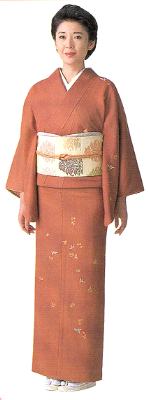Kimono - a traditional Japanese clothing worn by men, women and children. But very often in a kimono can see the women, as originally it was the clothing geisha. It is worn not only on holidays, but also in everyday days. For example, during the holidays trying to put a bright kimono, with a variety of patterns. It could be flowers, fish, birds and much more. Everyday is a kimono usually dark colors and simple colors. The same kimono differs from the material. This can be silk, which is more expensive, or cotton. For women's kimono as a symbol of femininity, purity and nobility. A popular if this type of clothing now?
Kimono - clothing fashionistas in our time, no magazine is complete without a photo shoot in a kimono. Heroes anime cartoons at least once appear on the screen in this kind of clothing. At the fashion show is always a collection of the most exciting colors. For example, in a popular magazine "Popteen" appeared advertising a new collection of "Kyoto Sweet Collection".
Kimono is chosen depending on age, marital status and type of event:
Kurotomesode - black kimono, having image just below the waistline. This is the most formal kimono for married women. It is also often used at weddings in dresses mother of bride and groom.
Furisode - kimono with long sleeves. This is the most formal kimono for unmarried women, it is worn bridesmaids on the wedding.
Irotomesode - monochrome kimono, painted below the waist. This type of kimono a little less formal than kurotomesode.
Tsukesage - ornaments are more modest than homongi. Most of them covers the space below the waist.
Iromudzi - it is worn by women in tea ceremonies. Fabric is always one color.
Comon - kimono with a fine figure, so they can be worn as a city and a restaurant.
Edo komon - kimonos in peas. In the Edo era it was worn samurai.
Uchikake - formal kimono, which are the bride or which appear on stage. Dresses over the kimono as a raincoat. Usually a bright color or white.
Mofuku - kimono, made of black silk. All accessories to the kimono, too black. He dresses in the day of the funeral processions.
This beautiful dress inspired and continues to inspire many people to write poems, paintings, to make a film and much more. Kimono - part of the history of Japan, which is not yet finished.















